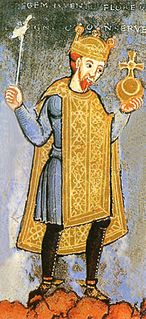
Pope Gregory VII, born Hildebrand of Sovana, was head of the Catholic Church and ruler of the Papal States from 22 April 1073 to his death in 1085. He is venerated as a saint in the Catholic Church.

Berengar of Tours, in Latin Berengarius Turonensis, was an 11th-century French Christian theologian and archdeacon of Angers, a scholar whose leadership of the cathedral school at Chartres set an example of intellectual inquiry through the revived tools of dialectic that was soon followed at cathedral schools of Laon and Paris. He came into conflict with Church authorities over the doctrine of transubstantiation of the Eucharist.

Year 1077 (MLXXVII) was a common year starting on Sunday of the Julian calendar.
Pope John X was the bishop of Rome and nominal ruler of the Papal States from March 914 to his death. A candidate of the counts of Tusculum, he attempted to unify Italy under the leadership of Berengar of Friuli, and was instrumental in the defeat of the Saracens at the Battle of Garigliano. He eventually fell out with Marozia, who had him deposed, imprisoned, and finally murdered. John’s pontificate occurred during the period known as the Saeculum obscurum.
The Gregorian Reforms were a series of reforms initiated by Pope Gregory VII and the circle he formed in the papal curia, c. 1050–80, which dealt with the moral integrity and independence of the clergy. The reforms are considered to be named after Pope Gregory VII (1073–85), though he personally denied it and claimed his reforms, like his regnal name, honoured Pope Gregory I.
In the medieval Roman Catholic church there were several Councils of Tours, that city being an old seat of Christianity, and considered fairly centrally located in France.

Guibert or Wibert of Ravenna was an Italian prelate, archbishop of Ravenna, who was elected pope in 1080 in opposition to Pope Gregory VII and took the name Clement III. Gregory was the leader of the movement in the church which opposed the traditional claim of European monarchs to control ecclesiastical appointments, and this was opposed by supporters of monarchical rights led by the Holy Roman Emperor. This led to the conflict known as the Investiture Controversy. Gregory was felt by many to have gone too far when he excommunicated the Holy Roman Emperor Henry IV and supported a rival claimant as emperor, and in 1080 the pro-imperial Synod of Brixen pronounced that Gregory was deposed and replaced as pope by Guibert.
Bruno the Saxon was a German chronicler of the eleventh century and author of the Historia de Bello Saxonico or History of the Saxon Wars.
Burchard of Basle, also known as Burkart of Fenis, Burchard of Hasenburg or Burchard of Asuel, was a Bishop of Basel in the eleventh century and a supporter of Holy Roman Emperor Henry IV (1056–1106).
Manasses I, known as Manasses de Gournay, was the Archbishop of Reims, and thus primate of France, from c. 1069 to his deposition on 27 December 1080.

The Diocese of Bergamo is a see of the Catholic Church in Italy, and is a suffragan of the Archdiocese of Milan. Geographically, Bergamo stood between the mainland interests of the Republic of Venice, and the territory of the Duchy of Milan. The duchy was regularly contested by the French and the Holy Roman Empire, which brought about repeated military operations. Internally, from the 12th to the 15th century, there was the usual party strife between the Guelphs, who generally supported the political and religious policies of the Papacy; and the Ghibellines, who generally supported the Emperors. As Kings of Italy, the emperors were feudal overlords of Lombardy.

The Archdiocese of Pisa is a metropolitan see of the Catholic Church in Italy. It was founded in the 4th century and elevated to the dignity of an archdiocese on 21 April 1092 by Pope Urban II. The seat of the bishop is the cathedral of the Assumption in the Piazza del Duomo.

The history of Corsica in the medieval period begins with the collapse of the Western Roman Empire and the invasions of various Germanic peoples in the fifth century AD, and ends with the complete subjection of the island to the authority of the Bank of San Giorgio in 1511.

The Diocese of Massa Marittima-Piombino is a Roman Catholic eccleasistical territory in Tuscany, central Italy. It was known as Diocese of Massa Marittima before 1978. Up until 1458, it was a suffragan of the archdiocese of Pisa; since 1458, it has been a suffragan of the Archdiocese of Siena. The territory of the diocese includes the islands of Elba and Pianosa, and Capraia.

The history of the papacy from 1046 to 1216 was marked by conflict between popes and the Holy Roman Emperor, most prominently the Investiture Controversy, a dispute over who— pope or emperor— could appoint bishops within the Empire. Henry IV's Walk to Canossa in 1077 to meet Pope Gregory VII (1073–85), although not dispositive within the context of the larger dispute, has become legendary. Although the emperor renounced any right to lay investiture in the Concordat of Worms (1122), the issue would flare up again.

The 1086 papal election ended with the election of Desiderius, abbot of Monte Cassino as Pope Gregory VII's successor after a year-long period of sede vacante.
Theoderic, or Thierry, was a royalist bishop of Verdun from 1047 to 1089. Before his consecration, he was a chaplain of Henry III.
Tedald was archbishop of Milan from 1075 to 1085.

Roland of Parma was an Italian cleric during the Investiture Controversy. He took the side of the Holy Roman Empire and served as the bishop of Treviso from 1073/1078 until 1089/1096.